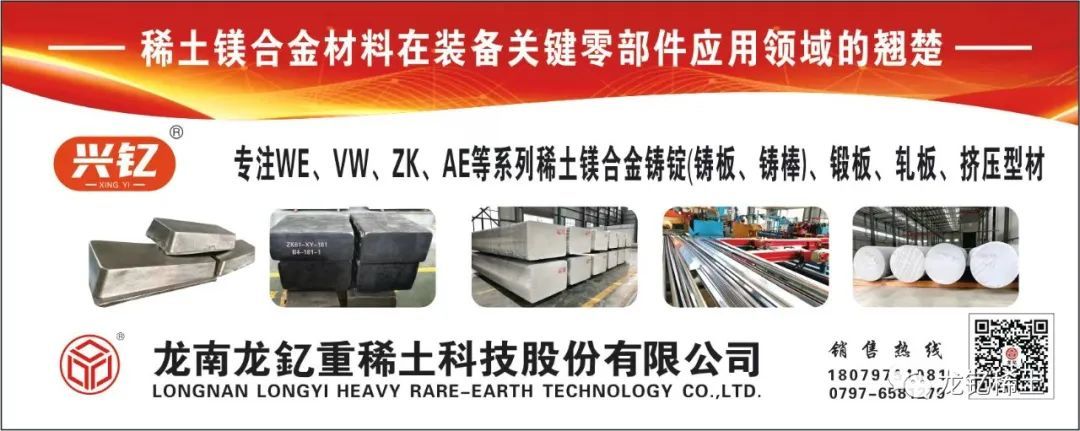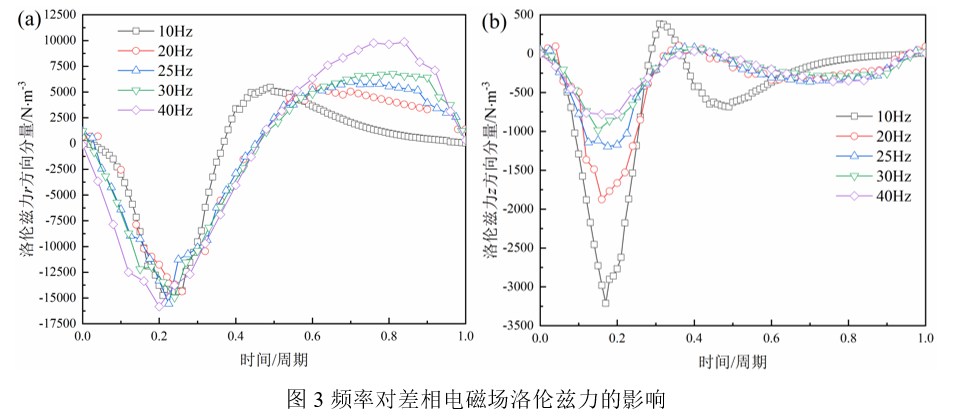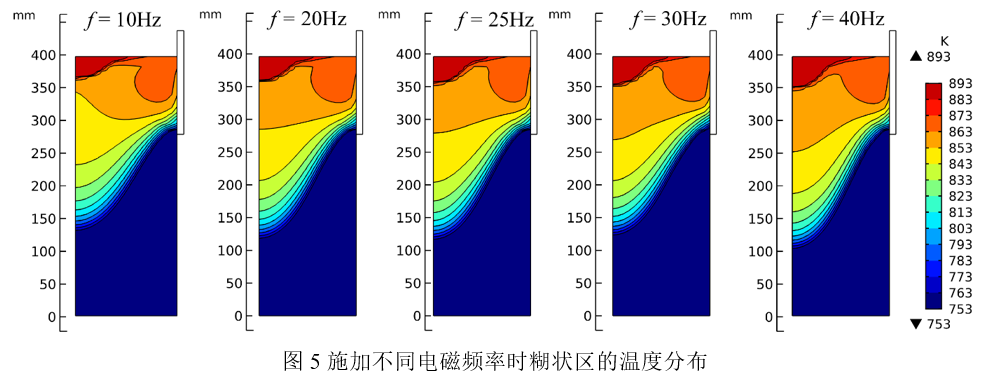11
2023
-
10
Professor Le Qichi Team of Northeastern University: Numerical Simulation of the Effect of Differential Phase Oscillation Electromagnetic Parameters on Convection and Heat Transfer of AZ80 Magnesium Alloy Ingot Casting Melt
Author:
It is included in many well-known databases at home and abroad, such as SCI-E, Elsevier Scopus, EBSCO, China Science Citation Database CSCD, HowNet, Wanfang, etc. The 2021 Impact Factor 1.045,JCR 3, is a WJCI-included journal, a core journal of Chinese science and technology, and was selected as the 2021 outstanding academic journal of international influence in China.

 |
It is included in many well-known databases at home and abroad, such as SCI-E, Elsevier Scopus, EBSCO, China Science Citation Database CSCD, HowNet, Wanfang, etc. The 2021 Impact Factor 1.045,JCR 3, is a WJCI-included journal, a core journal of Chinese science and technology, and was selected as the 2021 outstanding academic journal of international influence in China. |
research background
Compared with cast magnesium alloys, wrought magnesium alloys have better mechanical properties and wider application prospects, and their research and application have attracted extensive attention in recent years. As an important prerequisite for material deformation, the metallurgical quality of cast ingot billets directly affects the deformation behavior and service performance of the material. The magnesium alloy ingot prepared by the traditional semi-continuous casting process has the problems of coarse grain, uneven structure, segregation and serious oxidation inclusions. The application of electromagnetic field can effectively change the solidification behavior and significantly improve the flow field and temperature field of the solidification process, so as to effectively control the shape of the paste zone and liquid cavity, to refine the solidification structure, inhibit segregation, reduce the tendency of cracks, and improve the surface quality of the ingot. However, practice shows that the process window of traditional electromagnetic casting is narrow, and its effect is greatly limited by the operating conditions of the industrial site, which makes it difficult to match the electromagnetic effect with the cooling conditions, and the effect is not ideal. Therefore, it is of great practical significance to explore the application, effect and mechanism of new electromagnetic field in semi-continuous casting of magnesium alloy, so as to further improve the metallurgical quality of magnesium alloy ingots.
Professor Le Qichi's research group of the Key Laboratory of Materials Electromagnetic Process Research of the Ministry of Education of Northeastern University has nearly 20 years of accumulation in the theory and technology of magnesium alloy electromagnetic casting. Its low-frequency electromagnetic casting technology of magnesium alloy with independent intellectual property rights has been popularized and applied in the whole industry. On the basis of industrial application experience, in recent years, the research group has carried out persistent research on the new electromagnetic design and its application in magnesium alloy semi-continuous casting, and developed a new type of differential phase oscillation electromagnetic casting technology to further improve the metallurgical quality and stabilization level of magnesium alloy ingots. This will provide guidance for the design of industrial electromagnetic semi-continuous casting electromagnetic field generation system and the optimization of ingot casting process parameters.
Content Summary
Based on the multi-physics coupling numerical simulation method, this paper studies the electromagnetic distribution, melt flow and heat transfer behavior of AZ80 magnesium alloy round billet differential phase electromagnetic DC casting process under different electromagnetic parameters. The results show that the increase of current intensity only changes the size of Lorentz force, but does not change the distribution characteristics of Lorentz force; the maximum value of Lorentz force increases linearly with the increase of current intensity; with the increase of frequency, the r direction component of Lorentz force remains basically unchanged, and the z direction component decreases slightly. The change of current intensity is positively correlated with the melt oscillation, convection intensity and temperature distribution uniformity, but this does not mean that the higher the current, the better the metallurgical quality of the slab. In addition, the lower frequency is beneficial to produce more significant melt flow and velocity fluctuations, which is beneficial to form a more uniform temperature field. For the AZ80 magnesium alloy casting billet with a diameter of 300mm, the current intensity is 80 ~ 100A and the frequency is 10~20Hz.
Research Methods and Results
The research work reported in this paper is based on the transient coupling numerical calculation model of magnetic-current-thermal multiphysics and the measured current data under different electromagnetic parameters (current intensity and frequency). The influence of electromagnetic parameters on Lorentz force, flow field and temperature field in the semi-continuous casting process of AZ80 magnesium alloy ingot with a diameter of 300mm is systematically studied. Fig. 1 shows the changes of Lorentz force r direction component force (Fr) and Lorentz force z direction component force (Fz) at point c in a magnetic field cycle. it shows that with the increase of current intensity, Lorentz force has the same change trend, and its r direction component force changes continuously in magnitude and direction, and points to the inside of the melt (? The Lorentz force of r) is much greater than the force pointing to the edge (r), while the force in the z direction only changes in magnitude, and the direction always points to the inside of the liquid cavity. The increase of the current intensity only changes the size of the Lorentz force, and does not change its change law, and its maximum value increases linearly.

Figure 2 shows the temperature field of the stable stage of casting under different current intensities, which mainly reflects the temperature gradient of the paste zone, where the blue area is the solid area. It can be seen that with the increase of current intensity, the temperature of the internal melt decreases continuously, the area of the central low temperature zone increases, the area of the higher temperature zone at the edge gradually decreases, and the depth of the liquid cavity gradually decreases, which are 60.5mm (40A), 45.4mm (60A), 35.9mm (80A), 29.7mm (100A) and 27.4mm(120A), respectively. This is due to the Lorentz force to promote the increase of the melt circulation, accelerate the transfer of the center high temperature melt to the edge, and the high cooling rate of the edge of the melt temperature decreased rapidly, part of the low temperature melt with the circulation continues to transfer to the central area, so that the center temperature continues to decrease. This melt transfer capability increases as the current intensity increases.

the change of lorentz force with time in fig. 3 shows that with the increase of frequency, the r direction component of lorentz force pointing to the center of liquid cavity has no obvious change, while the maximum value of lorentz force pointing to the mould wall gradually increases, and the z direction component is much smaller than the r direction component. The maximum Lorentz force decreases gradually with increasing frequency, from 3212 N?m-3 at 10Hz to 778 N?m-3 at 40Hz. within a magnetic field cycle, in the first rise and fall interval of lorentz force, the component of lorentz force r direction is much larger than the component of z direction, and there is no obvious change in the size of the component of z direction in the following time.

Further analysis of the velocity change of the melt near the point c of the inner wall of the crystallizer at different frequencies shows that the lower the frequency, the greater the melt velocity, which is consistent with the trend of the Lorentz force, as shown in Figure 4. The variation of the maximum velocity and fluctuation amplitude with frequency shows that at lower frequencies (<30Hz), the maximum velocity decreases with the increase of frequency; when the frequency increases from 10 Hz to 20Hz, the oscillation amplitude of the velocity decreases. When the frequency is further increased, the oscillation amplitude of the velocity remains substantially unchanged.

As shown in Figure 5, when different frequencies are applied, the temperature field in the stable casting stage mainly gives the temperature gradient of the mushy area, where the blue area is the solid area. It can be seen that, compared with the change of temperature field caused by the change of current intensity, the change of melt temperature distribution caused by the change of frequency is not significant. With the increase of the frequency, the depth of the liquid cavity and the area of the central high temperature zone increase slightly, and the temperature change in the center is more obvious than that in the edge region.

In summary, with the increase of current intensity, the heat dissipation of the melt in the liquid cavity along the radial direction of the ingot is strengthened, the internal melt will quickly drop below the liquidus temperature, and the depth of the liquid cavity will gradually decrease. When the current intensity is greater than 100A, the temperature of the melt in the center of the liquid cavity is further reduced, while the temperature of the edge is slightly increased, and the temperature difference between the center and the edge of the melt reaches the minimum at 70 ~ 80A; when the differential phase oscillating electromagnetic field is applied, the frequency has little effect on the Lorentz force. With the increase of frequency, the maximum flow rate and velocity oscillation amplitude of the melt gradually decreased (10~30Hz), and finally remained unchanged (30~40Hz). The temperature of the melt in the center of the liquid cavity is more sensitive to the change of frequency, and a stronger melt convection and oscillation effect can be obtained at a lower frequency, which is conducive to obtaining a uniform temperature field. For the differential phase oscillation electromagnetic casting, the frequency parameters can be further adjusted to obtain a more uniform radial temperature distribution after the current intensity is adjusted to obtain a uniform temperature distribution at the edge of the liquid cavity.
Professor Le Qichi's Research Group
The magnesium alloy research team of the Key Laboratory of Materials Electromagnetic Process Research of the Ministry of Education of Northeastern University, led by Professor Le Qichi, is mainly engaged in the research of magnesium alloy solidification and casting, magnesium alloy plastic deformation, and the development of new deformed magnesium alloy. In recent years, with the support of projects at all levels of the Ministry of Science and Technology and the Natural Science Foundation of China, a series of important research results with independent intellectual property rights have been made in the fields of magnesium alloy field solidification and semi-continuous casting, magnesium alloy sheet/coil rolling, high extrusion plasticity magnesium alloy development, magnesium alloy electrochemical behavior and application, and have been steadily promoted in the industrial application of technological achievements and school-enterprise cooperation research, which has promoted the technological progress and benefit of the industry. The team currently has 8 fixed researchers, of which 5 have doctoral degrees, 4 have senior titles, and more than 40 doctoral and master students are studying.
The semi-continuous casting series technology formed by the team on the basis of the theoretical exploration of electromagnetic and ultrasonic field solidification has achieved remarkable results in the application of high-quality regulation of magnesium alloy billets, and has also made important progress in the preparation and application of other non-ferrous alloys such as copper and aluminum. More than 70 national invention patents have been authorized, and the full-specification application and promotion of magnesium alloy round billet and flat billet preparation technology have been realized in the industry, creating good social and economic benefits. In view of the limitations of the process effect and stability of the traditional low-frequency electromagnetic casting, the team has made new progress in the theoretical research of combined field oscillation casting and the complete development of semi-continuous technology and process equipment through the efforts of the past five years, providing a new solution for the upgrading and transformation of deformed blank preparation technology and equipment in the magnesium industry. In addition, in recent years, the team has also made important progress in the research on the theoretical model of magnesium alloy rolling deformation and the near-constant temperature rolling technology of high-precision wide-width plate coil, the development and application of new high-formability magnesium alloy, magnesium alloy composite materials and their preparation technology, magnesium alloy high-temperature oxidation resistance, magnesium air battery, etc.
Source: Foundry Magazine
Disclaimer: This article is reproduced on the Internet and is copyrighted by the original author. Only indicate the source of reprint, such as the wrong source, involving copyright issues, please contact us, we will be the first time to negotiate copyright issues or delete the content. The content is the original author's personal opinion and does not mean that this public number is responsible for its authenticity.
Summary of Common Metal Forming Process
2023-10-12









